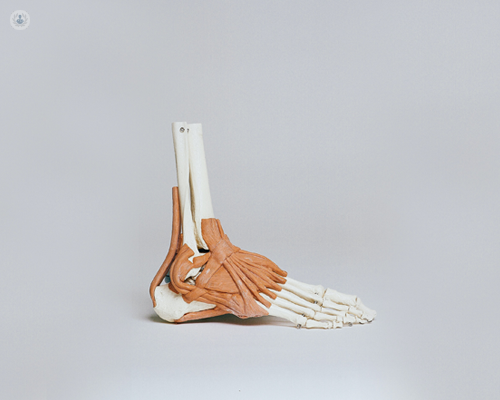Digging your heels in: All about plantar fasciitis
Escrito por:The tissue in the foot used during walking and other feet movements can become inflamed, causing heel pain and other symptoms.
This condition is called plantar fasciitis. Leading consultant orthopaedic foot and ankle surgeon Mr Shelain Patel goes into expert detail about it, in this informative article.

What are the common symptoms of plantar fasciitis, and how can it be distinguished from other foot conditions?
The classic symptoms of plantar fasciitis are heel pain which occurs first thing in the morning, before easing off as the day progresses and eventually getting worse again in the evening.
There is a myriad of different foot conditions which can cause heel and hindfoot pain, so, seeking the opinion of a specialist may be the only way to diagnose the condition.
What are the main causes and risk factors associated with developing plantar fasciitis?
When the tissue on the heel is subjected to too much load, it can become worn out and this is essentially what plantar fasciitis is; degenerate and thickened tissue where it attaches on to the heel bone (calcaneus).
The excess load may result from activities such as running, or walking on hard surfaces, or through too much body weight. There are certain conditions associated with patients with plantar fasciitis, such as:
- flat feet, and;
- tight calf muscles
What non-surgical treatments and home remedies are effective in relieving plantar fasciitis pain?
Various treatments and remedies include:
- stretching exercises;
- cushioned insoles and;
- shockwave therapy.
These form the mainstay of non-surgical management. It’s vital that stretches are performed daily and repeated throughout the day for maximal benefit.
Importantly, it may take many weeks and months to see an improvement. Occasionally a one-off steroid or PRP injection may be helpful, but it is paramount to realise that this is not a substitute for stretching and insoles.
When is surgery recommended for plantar fasciitis, and what are the surgical options available?
Surgery is recommended if non-surgical treatment has been exhausted and failed. There are two main surgical options which are to either release the tension in the calf muscles or to divide the plantar fascia at its origin on the heel bone.
How can I prevent plantar fasciitis or reduce the risk of recurrence after treatment?
Unfortunately, plantar fasciitis cannot be prevented. However, using sensible cushioned foot wear, and maintaining the flexibility in the calf muscles can reduce the risk of recurrence.
If you require expert treatment for plantar fasciitis, arrange a consultation with Mr Patel via his Top Doctors profile


